Top Bedroom Paint Colors of 2021 to Refresh Your Space
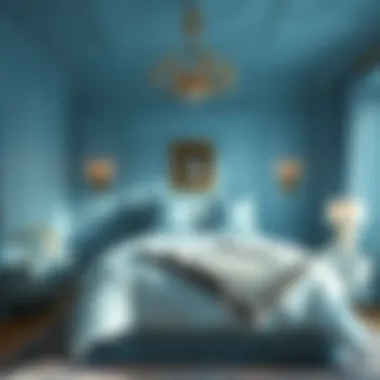
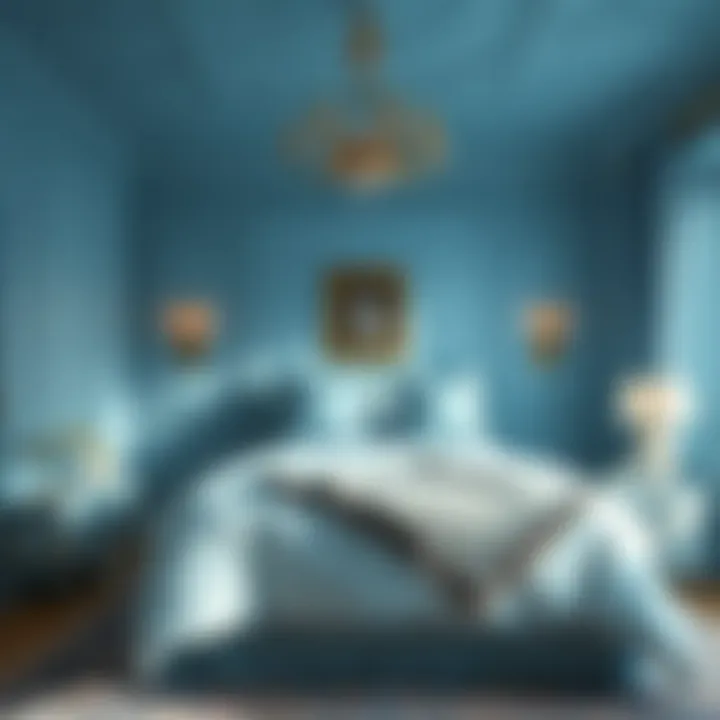
Intro
Color plays a pivotal role in shaping our environments and, by extension, our emotions. The bedroom, typically seen as a personal sanctuary, is especially influenced by the hues that adorn its walls. In 2021, we witnessed a remarkable shift in the trends surrounding bedroom paint colors, fueled by a blend of psychology, design principles, and evolving aesthetic preferences. Throughout this article, we will delve into the most popular color choices for bedrooms this year, exploring not only their visual impact but also the emotional resonance they hold.
Whether you’re contemplating a full renovation or a simple refresh, understanding these colors' significance and ambiance-generating qualities is essential. We will highlight key points about trending styles, practical advice on how to incorporate these palettes effectively, and even provide product recommendations to complement your newly painted haven. So, grab a cup of tea, sit back, and let's dive into the colorful world of bedroom transformations.
Preamble to Bedroom Colors
The bedroom is often considered a sanctuary, a personal retreat where the strains of everyday life can be forgotten. Choosing the colors that adorn this space plays a crucial role in shaping its overall atmosphere. In this article, we'll take a closer look at how color impacts not only the visual appeal of a bedroom but also how it influences our emotions and well-being.
When selecting a paint color for your bedroom, the choices can feel overwhelming. It's not just about what looks good on the walls. Each hue carries its own weight of meaning and can elicit specific responses from those who spend time in the room. Therefore, understanding the significance of bedroom colors is paramount. For instance, warm tones like terracotta may evoke feelings of coziness and security, while cooler shades like blue can bring about a sense of calm and tranquility.
Benefits of Thoughtful Color Selection
- Mood Enhancement: The right color can turn a dreary space into a welcoming one. Colors can uplift, soothe, or even invigorate. A mindful color choice makes it more likely that the bedroom becomes a place to truly relax or recharge.
- Design Cohesion: The colors you choose should align with your personal style and harmonize with the rest of your home. A coherent color scheme contributes to a unified aesthetic.
- Psychological Influence: Many studies highlight how color affects our mental state. For instance, soft greens have been found to have restorative effects, making them a fantastic option for a restful environment.
- Personal Reflection: The color palette selected for your bedroom can serve as a snapshot of your personality and preferences. It's an opportunity to express individuality through your choices.
Considerations for Bedroom Colors
- Natural Light: How light interacts with color can change the way a room feels at different times of the day. A color that appears soft and inviting in morning light may feel harsh at night.
- Room Size and Shape: Lighter hues can make a small space feel bigger, while darker shades may provide a sense of intimacy but can also shrink the visual space.
- Existing Decor: The colors already present in your furniture and furnishings should guide your choices for wall colors to maintain balance.
In summary, understanding the role of color in bedroom settings is key to elevating your space. Whether you're opting for a soothing palette or looking to infuse bold energy, the colors you choose can significantly impact your overall experience at home.
Significance of Color in Bedroom Design
Understanding how color works in bedroom spaces is crucial for anyone looking to create a welcoming haven. The bedroom, often seen as a sanctuary, is deeply influenced by the colors that adorn its walls. Each hue has its own aura and can significantly affect the overall vibe of a room. When you step inside, the first thing that greets you is its visual palette, and subconsciously, it begins to influence your emotions and behaviors.
The right color choice can lead to improved relaxation and sleep quality, while poor choices may leave you restless or out of sorts. Color in a bedroom isn't just about aesthetics; it's about creating an environment that can make you feel at ease after a long day. Imagine, for instance, sinking into a bed surrounded by soft blues or greens that embody calmness—these shades promote tranquility, while vibrant reds or yellows could stir up more energy than you'd want at bedtime.
Additionally, color can be a useful tool for personal expression. From the zen-like serenity of whites and soft pastels to the bold statements made by deep jewel tones, colors enable homeowners to showcase personality, style, and comfort preferences. A thoughtfully selected palette can elevate a simple bedroom into a space that reflects who you are.
Ultimately, when redesigning a bedroom, considering color's technical and emotional significance plays a foundational role in ensuring that the space serves its purpose well— being a peaceful retreat where one can recharge and rejuvenate.
Psychological Effects of Color
Color psychology delves into how colors influence mood and behavior, particularly in intimate spaces like a bedroom. Each category of colors evokes different feelings. Recognizing these effects can help significantly in making the correct choices.
Calming Colors
Calming colors play a pivotal role in promoting restfulness and tranquility. Hues such as gentle blues, soft greens, and delicate lavenders fall into this category. They create soothing atmospheres that ease stress and promote relaxation. When a bedroom is painted in these shades, it can feel like an invitation to unwind the moment you walk through the door.
For example, a light seafoam green could give off a refreshing, airy feel. This color draws upon the serenity of nature, making it a popular choice for those who want to promote feelings of calm and peace. Such colors are beneficial, especially in today’s fast-paced world, where everyone seems to be on edge. However, it's essential to balance these soothing colors with some accents or textures; otherwise, they might lead to a monotone look that feels flat or uninspired.
Stimulating Tones
On the flip side, we have stimulating tones which inject energy into a space. Bright yellows, bold oranges, and vivid reds are perfect examples of this. A splash of these colors can invigorate a room and provide a lively atmosphere. In bedrooms designed for creativity or activity—like a child's room—these vibrant shades might be a favored choice.
For instance, an accent wall painted in cherry red can serve as a focal point, energizing the space and encouraging enthusiasm and motivation. This doesn't mean you should paint an entire bedroom in such intense hues. Instead, a well-placed vibrant accent can draw attention and elicit excitement while resonating positively with one's personality. However, overuse can lead to overstimulation or even fatigue, so moderation is key.
Color and Mood Regulation
Colors also play a significant role in regulating our mood. The psychological responses elicited by colors can shape our emotional and mental states, impacting how relaxing or invigorating our spaces feel.
Serenity and Restfulness
Achieving serenity and restfulness through color is paramount for bedroom designs dedicated to fostering a peaceful night’s sleep. Soft shades of blue or beige create ambient tranquility. When light filters through windows highlighting these hues, it can be transformative. They create a cocoon-like effect that brings comfort and easing the mind's chatter at the end of a long day.
It’s no wonder that many people gravitate toward pale shades of gray when redesigning their bedrooms. Gray can reflect light beautifully and bring depth without overwhelming the senses. It enhances the calming effect while still allowing for personality through decor and other elements. The main aim is to ensure that the interplay between light and color creates a relaxing retreat. However, too much gray, if not carefully balanced, can sometimes bring forth a sense of gloom, which is undesirable.
Energizing Environments
Conversely, creating energizing environments is suitable for spaces intended for activities, such as a home office or a creative studio nook within a bedroom. The significance of color here lies in its ability to stimulate creativity and productivity. Color combinations with warm undertones can enkindle enthusiasm and drive.
For instance, bright yellow along with daylight can invigorate an otherwise mundane space. For those looking to combine restful sleep with daytime productivity, strategic use of energizing colors on furniture or accessories may offer the perfect balance. But one must tread carefully; too many bright colors can quickly lead to chaos if not paired properly with soothing surroundings.
In summary, choosing the right color in bedroom design encompasses psychological aspects, mood regulation, and personal expression. By recognizing the effects of both calming and stimulating colors along with understanding how they contribute to serenity and energizing environments, homeowners can create a carefully curated space tailored to their desire and needs.
Trends in Bedroom Colors for
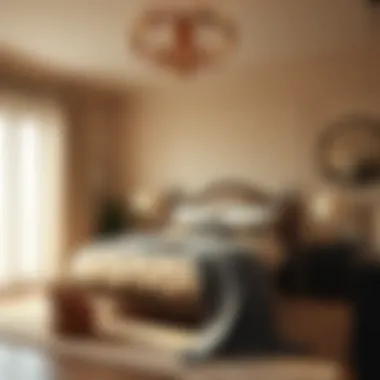
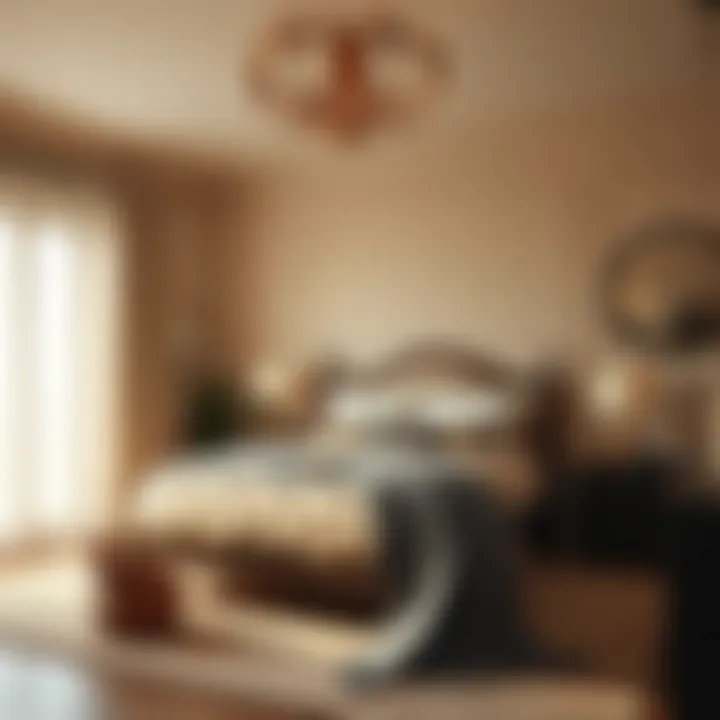
In 2021, the evolution of bedroom colors is not merely about aesthetics; it's a reflection of our collective mindset during a tumultuous time. People sought a balance between serenity and vibrancy, leading to choices that resonate with personal preference and environmental context. Staying in tune with the pulse of societal needs, these color trends not only enhance the visual appeal but also serve practical purposes, influencing mood, calming anxious thoughts, or igniting creativity. The bedchamber, often regarded as a sanctuary, embodies these contemporary shifts. Hence, the importance of understanding these trends cannot be overstated—every shade tells a story.
Fashion-Forward Shades
Pale Earth Tones
Pale Earth Tones have taken center stage in 2021, bringing a breath of fresh air to bedroom design. These hues, such as soft taupes and muted beiges, evoke a sense of grounding and connection to nature. In an age where many are striving for simplicity and calmness amidst chaos, these shades act as a serene backdrop. They can create an inviting ambience, perfect for relaxation after a long day. Moreover, Pale Earth Tones harmonize effortlessly with natural materials like wood, textiles, and stone. Their understated elegance makes them a popular choice in modern and traditional styles alike. However, one must be cautious; while they promote tranquility, an excessive use could render a space monotonous. A careful balance must be sought to maintain vibrancy.
Muted Pastels
Muted Pastels emerged as another striking trend for bedrooms in 2021. Think soft lavender or faded blush pink, colors that whisper rather than shout. They bring warmth and a delicate touch without overwhelming the senses. These shades are an excellent option for those looking to sprinkle subtle colors into their spaces without committing to bolder tones. The unique feature of Muted Pastels lies in their versatility; they work wonders in layering with other colors to create a cohesive look. While popular for their gentle appeal, it's essential to keep in mind that pastels need adequate lighting to truly shine. Poor lighting may lead them to appear washed out, losing their charm.
Bold Choices
Dramatic Dark Colors
Dramatic Dark Colors, such as deep navy or rich plum, made quite a statement in 2021. These shades add depth and character, capable of transforming an ordinary bedroom into a sophisticated enclave. They bring a certain level of drama that can invoke coziness and warmth, perfect for a space meant for rest. Dark colors emphasize architectural features and furnishings, creating a rich tapestry of contrasts. However, one must tread lightly with these shades. Rooms painted in dark colors may feel smaller if not designed wisely. Bright accents and strategic lighting can remedy the potential gloominess.
Vibrant Accents
Vibrant Accents are where the fun begins. Bright hues like coral or emerald can revitalize any bedroom and bring a sense of energy. They serve as focal points, making the space more dynamic and engaging. An accent wall, bright bedding, or even artwork in vivid colors can shake up the monotony and reflect individual personality. The charm of using Vibrant Accents lies in their ability to be easily altered. If today's trendy coral doesn't speak tomorrow, it's a simple matter of swapping it out for something fresh. However, too much vibrancy can overwhelm; moderation is key to ensure the space remains inviting rather than chaotic.
In summary, the trends in bedroom colors for 2021 reflect a blend of calming elements and bold expressions. The overarching theme is to create environments that nourish the soul while showcasing unique styles. These trends provide ample room for exploration as homeowners navigate the balance between personal expression and serene living.
Most Popular Paint Colors of
In the world of interior design, especially within the confines of one's bedroom, color holds sway like a maestro conducting an orchestra. The colors chosen for a bedroom are not just about aesthetics; they can fundamentally impact the occupants' mood, sense of tranquility, and overall comfort. The most popular paint colors of 2021 reflect emerging trends that many homeowners have gravitated toward, signaling a collective desire for serenity, connection with nature, and bursts of joy. Yet, selecting the right hue extends beyond following trends. It involves understanding the nuanced interplay of colors and personal style.
Exploring popular paint hues can provide valuable insights into how homeowners make choices that resonate most. Moreover, the right color can lift a space from drab to fab, creating a haven that individuals can identify with. This section delves into some of the standout colors for bedrooms in 2021, emphasizing neutral shades, cool blues, and earthy greens, each with their own set of reasons for being favored this year.
Neutral Shades
Neutral shades have carved a distinctive niche in the realm of bedroom paints, serving as versatile backdrops that foster relaxation. These colors not only complement various styles but also allow homeowners the flexibility to swap out decor as trends come and go.
Greige
Greige, a blend of gray and beige, has emerged as a favorite in bedrooms due to its inherent warmth and versatility. Its understated elegance promotes a sense of calm without being too stark or cold. One of the defining characteristics of greige is its ability to adapt to different lighting conditions; it can shift from cool to warm tones throughout the day. This flexible nature makes it a beneficial choice for individuals looking to create a soothing ambiance that's not overly imposing. However, one challenge may be that it can sometimes appear flat if overused in larger spaces. A well-placed piece of art or an accent fabric can easily remedy that.
Warm Whites
Warm whites offer a clean yet inviting canvas that resonates with both modern and traditional aesthetics. This particular shade often has a hint of yellow or beige, which softens the starkness typically associated with brighter whites. The light that warm whites reflect creates a bright, airy feeling, making small bedrooms feel larger and more comfortable. Moreover, these whites are forgiving, allowing for easy layering with different decorative elements. A potential downside might be their tendency to show dirt or wear more quickly than cooler whites, demanding regular upkeep.
Cool Blues
Cool blues have taken center stage in 2021, embodying the tranquil essence often associated with a clear sky or calm sea. These shades can act as a balm for the senses, offering a reprieve from the outside world.
Soft Sky Blue
Choosing soft sky blue introduces a light, breezy sensation within the bedroom. Its pale undertones evoke feelings of serenity and clarity, making it ideal for spaces where relaxation is a priority. This color embodies tranquility - a direct means to enhance emotional well-being after a long day. Interior designers often lean toward this option for bedrooms, as it creates a soothing retreat. However, too much blue might be perceived as uninspiring if not balanced with other vibrant hues or textures.
Deep Navy
On the opposite end of the spectrum lies deep navy. This rich, dark hue adds depth and sophistication to a room while providing a striking contrast against lighter decor. A key feature of navy is its versatility; it can be both elegant and dramatically bold, depending on how it’s combined with other colors. The weight of deep navy can create a cocoon-like effect, ideal for someone seeking comfort. Caution must be taken, however, as dark shades may make a smaller room feel claustrophobic without strategic lighting and decor to enhance its presence.
Earthy Greens
Earthy greens have emerged as a reminder of our connection to nature, resonating strongly with those looking to bring a sense of balance and renewal into their living spaces.
Sage Green
Sage green is a subtle, muted hue that embodies the tranquility of nature. Its understated quality allows it to blend seamlessly with various design elements. The calming effects of sage green can create a sanctuary-like atmosphere, making it especially appealing for bedrooms dedicated to relaxation and rest. This color often enhances natural light and can add a touch of freshness without overwhelming the space. However, balancing sage green with other colors is crucial to avoid making a room feel overly monochromatic.
Forest Green
In more dramatic fashion, forest green provides richness and depth, reminiscent of thick woodlands. This shade can imbue a bedroom with elegance and depth while acting as a statement color. The key advantage of forest green lies in its ability to instill a sense of peace and restfulness, echoing the serenity one might find in nature. A potential downside is that it may dominate the room if not offset by lighter colors or textures, so careful coordination with decor elements is recommended.
Implementing Color in Bedroom Design
When it comes to designing a bedroom, color choice plays a pivotal role in not only establishing the aesthetic quality of the space but also in shaping the overall atmosphere. Implementing color in bedroom design means more than just slapping one coat of paint on the walls. It involves a thoughtful approach where the interplay of shades can breathe life into your personal sanctuary. The significance of this aspect is realized through various elements such as emotional resonance, functionality, and personal expression in design.
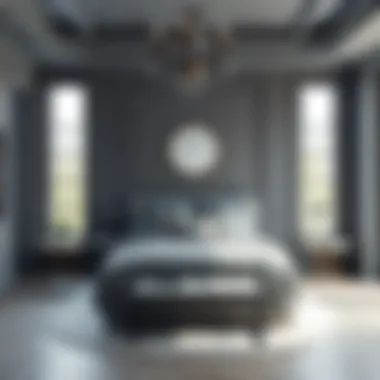
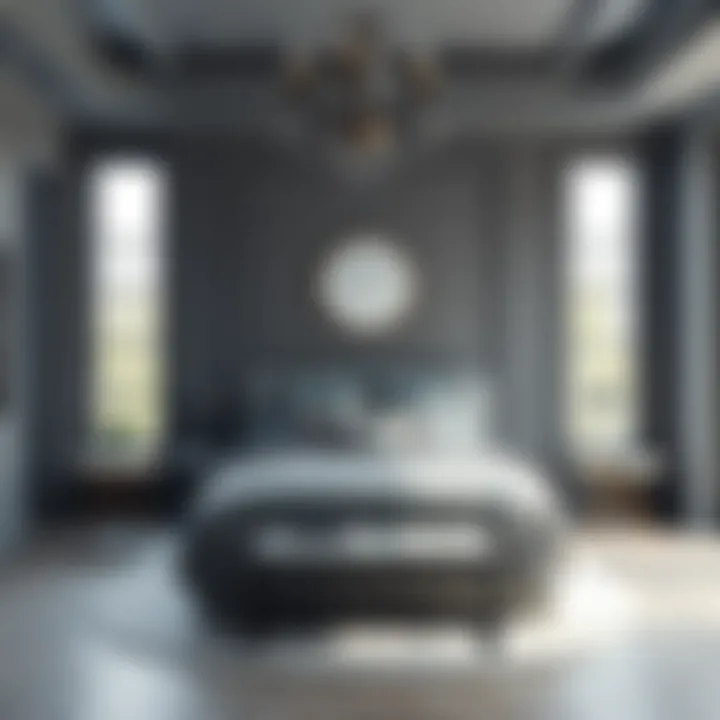
One clear benefit is how color directly influences mood and comfort. Soft hues like lavender or powder blue can bring a sense of tranquility, setting the stage for restful sleep. On the flip side, vibrant colors may infuse energy into the room, making it feel livelier. Thus, strategizing on the color palette can enhance functionality tailored to how the bedroom will be used—be it for relaxation, reading, or even work.
Choosing the Right Hue
A well-chosen hue can turn a mundane room into a visual wonderland. But how do you determine what’s right for your space?
Assessing Room Lighting
Assessing room lighting serves as a cornerstone of successful color implementation. Lights can either wash a color out or intensify its vibrancy, depending on their type and placement. Natural light, for instance, brings out the true essence of paint colors, making them appear different at various times of the day. This makes it a crucial step in choosing colors that harmonize with the existing light.
The beauty of assessing room lighting lies in its specificity. Cool daylight can revitalize a hue, while warm incandescent bulbs can mellow it. Ignoring this detail might lead to paint colors that clash with your intended design.
For instance, sodden lighting could turn a bright yellow into an unflattering mustard, something you'd want to avoid. This understanding leads to an informed choice, saving both time and resources.
Testing Samples
Testing samples is another vital part of color selection. It’s an essential practice that allows homeowners to observe how a color interacts with the existing elements in the room. This small step can reveal whether a color elevates the space or leaves it feeling flat. As practical as it is illuminating, this process takes the guesswork out of choosing a paint shade.
In the age of digital design tools, nothing beats a real-life sample. Applying a tester patch on your wall lets you see how the color changes throughout the day with different lighting. This first-hand experience can be both exciting and reassuring.
However, one should keep in mind that testing a sample might lead to what some would call 'decision fatigue.' It’s easy to get lost in a sea of choices when you’re bombarded with too many options. Yet cautiously narrowing them down based on daily lighting patterns helps in making a sound choice.
Combining Colors Effectively
Once the right hue is decided upon, the next step is effective color combination. This consideration can transform a simple paint job into artful expression within a bedroom.
Accent Walls
Accent walls are a popular method for incorporating color while keeping a sense of balance in the room. By choosing a wall to showcase a bold color, you can create a focal point that draws the eye. This technique plays well with lighter or neutral backgrounds, allowing for a dramatic contrast that’s visually striking yet sophisticated.
The allure of accent walls lies in their versatility. Whether you go for a startling teal or a subdued charcoal, accent walls can tell a story without overwhelming the senses. However, it's vital to ensure the chosen color aligns with the overall theme of the bedroom, as a mismatch might feel jarring rather than inviting.
Complementary Color Palettes
Finally, the concept of complementary color palettes brings a sense of cohesion to any room. Pulling together colors that are opposite on the color wheel could foster a refreshing look. This practice is widely considered a method to maintain harmony while allowing unique characteristics to shine through.
Complementary palettes have the unique capability to enrich the layout without competing for attention. For example, pairing rich navy with warm copper tones can establish an elegant relationship that enhances both colors.
On the downside, blindly following complementary rules may result in drab execution if not executed thoughtfully. Careful consideration of which shades complement and how they can coexist in a space is crucial for achieving a successful look.
Case Studies of Color Usage
When it comes to interior design, especially in the bedroom, the use of color plays a pivotal role in shaping the atmosphere and overall aesthetic. Delving into specific case studies of color usage sheds light on how different styles and historical influences converge to create unique environments. Analyzing these case studies provides insights into practical applications of color theory and helps individuals make informed decisions when revamping their personal spaces.
Contemporary Styles
Minimalism with Monochrome
Minimalism with monochrome is a design approach that focuses on simplicity and a limited color palette. This style emphasizes clean lines and clear spaces, which can contribute to a sense of calm and order in a bedroom. The key characteristic of this approach is its reliance on a single color or various shades of the same hue, which can create an illusion of depth without visual clutter.
Adopting a monochrome scheme can be particularly beneficial as it fosters an uncluttered aesthetic, making the space look larger and more serene. A unique feature of minimalism is how it allows one to highlight architectural details or furnishings without the distraction of competing colors. However, one disadvantage might be that overly strict adherence to this style can result in a space that feels cold or impersonal if not balanced with texture and soft furnishings.
Bold Color Statements
In stark contrast to minimalism, bold color statements embrace vibrancy and expression. This design choice often involves incorporating striking hues to create an energetic and dynamic atmosphere. The standout quality of bold color statements is their ability to evoke emotions and create focal points within a room. By using deep reds, bright yellows, or intense blues, a space can become a canvas for personal expression.
The benefit of this approach is its potential to invigorate a space where imagination takes flight. It allows homeowners to infuse their personality into their environment. However, one must be cautious; an overwhelming use of bold colors can easily turn a bedroom into a chaotic blend that distracts rather than inspires. Thus, balancing these vivid tones with neutral elements becomes crucial.
Traditional and Classic Designs
Historical Color Schemes
Historical color schemes draw inspiration from different eras, reflecting the tastes and trends that defined those times. Integrating these colors can add a layer of elegance and nostalgia to bedroom design. The hallmark of this approach is its ability to tell a story through color, showcasing options such as soft creams, rich burgundies, or muted greens that hark back to earlier periods.
The advantage of using historical colors is their timelessness; they evoke a sense of familiarity and comfort that can be inviting. They are often soft and harmonious, creating a warm and cozy atmosphere. However, one potential drawback is that such schemes might lack the modern edge that some homeowners crave. Thus, blending historical colors with contemporary elements may provide a solution, merging both worlds.
Timeless Combinations

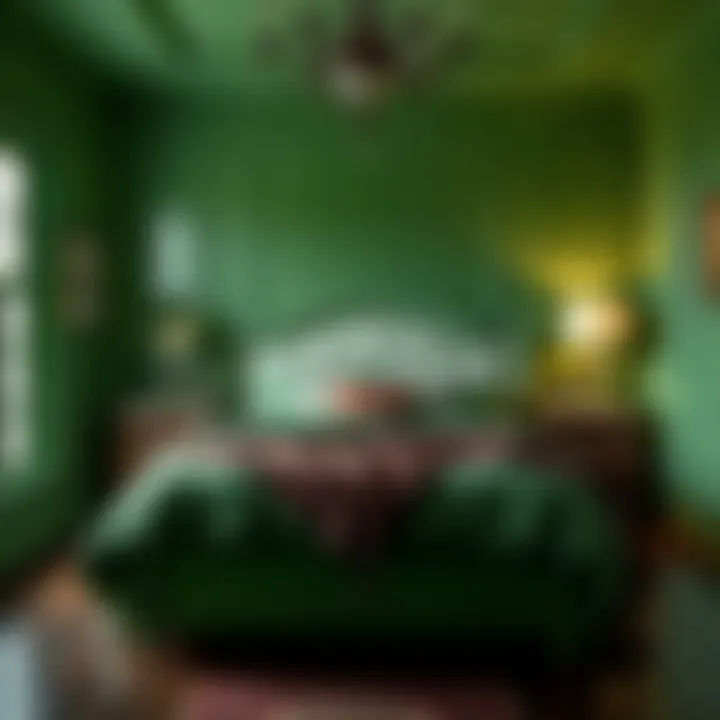
Timeless combinations build on the premise that certain color pairings never go out of style. This approach often includes classic duos such as navy and white, beige and brown, or gray and blush. The appeal of timeless combinations lies in their versatility; they work seamlessly across different styles and eras, ensuring that the bedroom remains relevant regardless of changing trends.
The unique feature of timeless color schemes is their ability to adapt, allowing homeowners to introduce new accessories, art, or furniture without feeling the need to overhaul the entire room. This adaptability is a significant advantage, as it promotes long-term satisfaction in the space. On the flip side, a safe choice may sometimes be perceived as uninspired, so it is essential to add personal touches that give character and individuality to the space.
The careful selection of colors in bedroom design not only influences the aesthetic but also impacts emotional wellness and personal expression.
In summary, studying various case studies of color usage reveals foundational insights into how different styles reflect personal preferences. By considering both contemporary and traditional methods, it’s possible to explore an extensive range of color options that cater to every unique taste, ultimately resulting in personal sanctuaries that resonate on deeper levels.
Personalization Through Color
Personalizing your bedroom through color is more than just aesthetics; it's a way to express your identity and create a space that feels uniquely yours. The right colors can transform not only the look of the room but also how you feel in it. In 2021, there's a strong emphasis on tailoring your color choices to reflect personal style and individual preferences. This is especially relevant in an age where many seek comfort in their homes, wanting to feel a sense of belonging and peace in their personal sanctuary.
Colors have the power to provoke emotions, set the tone for relaxation or energy, and contribute to the overall ambiance of a space. By choosing hues that resonate with your personality, you create an environment that fosters comfort and inspiration. The process of selecting colors becomes an intentional act of understanding oneself and defining one’s personal space.
Incorporating Personal Style
Finding Your Palette
Finding your palette is a crucial step in the journey of creating a bedroom that mirrors who you are. This phase involves exploring various shades and hues that speak to your personal style. It's about considering how colors harmonize with your lifestyle, preferences, and the overall mood you want to evoke in your room. One key characteristic of this stage is its flexibility; there are no rigid rules. This approach allows for dynamic exploration, encouraging you to discover unique combinations that may surprise you.
A significant advantage of finding your palette is how empowering the process can be. When you identify and select colors that resonate with you, it fosters a deep sense of ownership over your space. On the flip side, some might find it challenging to step outside the norm, leading to the temptation to stick with safe, familiar colors.
Mixing Styles
Mixing styles can bring a refreshing twist to your bedroom design. This aspect often involves blending different color schemes or integrating various design elements to create a personalized sanctuary that reflects multiple facets of your personality. The beauty of mixing styles lies in its versatility, as it can cater to both the minimalist and the maximalist tastes effectively.
One key characteristic of mixing styles is the ability to create a visually interesting space that tells a story. It allows for experimenting with textures and colors without feeling confined to a single aesthetic. However, this approach can sometimes veer into chaos if not managed thoughtfully—balancing is essential to prevent a clash that might detract from the desired atmosphere.
Reflecting Personality in Color Choices
Color and Identity
Color and identity go hand-in-hand when it comes to bedroom design. It’s about how particular shades resonate with personal experiences, memories, or even aspirations. By choosing colors that reflect your identity, you can create an emotional connection to your space, which enhances your feeling of belonging. This characteristic contributes significantly to the overall comfort of your bedroom.
One of the benefits of focusing on color and identity is that it allows for genuine self-expression. When you paint your walls in colors that embody who you are, your room starts to feel like a true extension of yourself. However, this journey may also pose some hurdles; people's tastes evolve, and a color that once felt right might no longer resonate with them over time.
Mood-Based Selections
Mood-based selections focus on how specific colors can influence feelings and atmospheres within a bedroom. This aspect is essential for homeowners looking to create a certain vibe, be it calming, energizing, or eclectic. One of the most appealing characteristics of mood-based selections is their scientific backing; colors indeed influence human emotions and behaviors in various ways.
The advantage of making mood-based selections is clear: it enables you to create a tailored atmosphere that goes beyond mere visual appeal. However, this method requires careful consideration; you might find it challenging to balance personal preference against the psychological effects of color, leading to the dilemma of sacrificing personal taste for emotional impact.
Ultimately, balancing personal style with mood-based choices can create a harmonious ambiance that resonates deeply with the inhabitant's soul.
Final Thoughts on Bedroom Paint Colors
Choosing the right paint colors for a bedroom is more than just following trends; it’s about creating a space that resonates with one’s personal style and emotional well-being. The colors on the walls can either uplift or dampen spirits; therefore, the significance of understanding and selecting the appropriate shades cannot be overstated. This approach isn't just for aesthetic purposes; it's about crafting a sanctuary where one can unwind and recharge. In the context of 2021, the colors that became popular were not just whimsical choices—they were grounded in a growing awareness of their psychological effects and how they influence everyday life.
Balancing Trends with Timelessness
Evaluating Preferences
Evaluating preferences involves assessing one's style and the emotions that specific colors evoke. It requires looking beyond current fads and considering what flavors will last through the years. The key characteristic of this evaluation is its deeply personal nature—no one can dictate what feels right within your own walls. For this article, it's vital as it emphasizes a thoughtful approach to color choice. Rather than simply jumping on the latest bandwagon, homeowners are encouraged to tap into their instincts and establish a palette that complements their individual tastes.
A unique feature of evaluating preferences is that it can lead to unexpected combinations. For example, a house owner who loves classic blue might pair it with a muted pastel to create a more dynamic yet serene environment. The advantage here lies in the ability to tailor one's bedroom in a manner that feels uniquely suited to the owner, despite what might be trending.
Long-term Satisfaction
Long-term satisfaction in bedroom colors refers to the idea of selecting hues that won’t just be appealing today, but will also endure over time. The key characteristic of this satisfaction lies in its sustainability—colors that wear well psychologically and stylistically. This is salient for a homeowner who does not want to repaint every year, as frequent changes can become excessive and financially draining.
When reflecting on this aspect, a unique feature is the physiological comfort that arises from cozy colors like warm whites or soft greens. These selections often maintain a soothing ambiance without going out of style, providing constant visual pleasure. The advantage here is the harmonious blend of style and functionality, allowing for lasting enjoyment without the stress of continuous updates.
The Future of Bedroom Colors
Emerging Trends
The landscape of bedroom colors is evolving, with emerging trends hinting at more diverse choices in the coming years. This includes less conventional colors that still carry a depth of emotional resonance, such as charcoal grays or deep jewel tones. The key characteristic of these emerging trends is their ability to push boundaries while remaining approachable. They add a touch of modernity without veering too far off the comfortable end of the spectrum.
In this article, highlighting these trends allows readers to explore unique options that break free from the conventional palette. A unique feature here is the integration of these colors into multi-functional spaces, allowing creativity to take center stage. This presents a disadvantage too, as not all may feel confident integrating such bold colors into their homes, thus requiring further exploration and experimentation.
Sustainability Considerations
Sustainability considerations in bedroom paint reflect a growing consciousness about how the materials used in our homes affect not just our immediate environment but also the broader ecosystem. The key characteristic of focusing on sustainability is its focus on eco-friendly options that do not compromise on aesthetics. This is beneficial for today's homeowners, who are increasingly inclined to choose paints free from harmful chemicals, aligning with a healthier lifestyle.
A unique feature of sustainability is the trend towards using paints that may incorporate plant-based materials or recycled elements, ultimately lowering environmental impact. The advantage of this shift is a dual benefit: preserving personal health and contributing positively to the planet. However, the disadvantage could be a higher price point associated with some sustainable products, which may deter budget-conscious homeowners.



